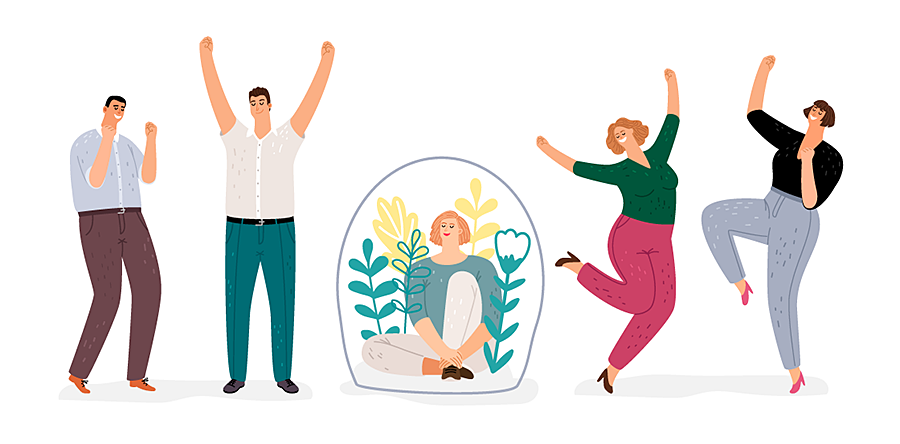Only 23% of Canadian workers would feel comfortable talking to their employer about a psychological health issue. [1] The average employee spends about seven working days per year stressed out about a work-related problem instead of coming forward with their concern. Often, it is because they don’t feel their workplace is psychologically safe.
Employees who don't feel psychologically safe are likely to feel apprehensive about expressing concerns for fear of being judged or negatively affecting their job security or status. This reluctance to speak up and deal with an issue can cost employers as much as $7500 per employee in lost time and resources. [2]
Do your employees feel safe to speak their mind without fear of repercussion?
If not, it may be because they feel isolated and are lacking critical social connections in the workplace.
When employees feel socially disconnected from peers and managers, and lack the confidence to speak up, they can feel uncertain about the future and what is going to happen to them. If left unchecked, these feelings can lead to loneliness and will have a profound impact on their outlook toward work and their overall mental health.
Leaders see only the tip of the iceberg
A psychologically safe workplace promotes employees’ psychological well-being and actively works to prevent this type of harm. However, it is not always easy to see when an employee’s psychological safety is at risk.
They may be having different experiences than what you observe. You may not be aware of a lack of trust or feelings of anxiety. People can give the impression that everything is okay when, in reality, below the surface, they’re experiencing some degree of worry or even fear.
You want to ensure that each of your employees has at least one psychologically safe relationship in the workplace, so no one feels isolated and lonely and they have the confidence to self-advocate.
Create a psychologically safe workplace where employees feel connected and more confident
Creating this type of environment requires you to look not only at your own relationships with employees, but also the relationships they form with their peers and supervisors.
Here are a few tips to get you started.
- Talk about psychological safety - Start the conversation by talking openly about psychological safety, what it means to employees, and why you value it in your workplace. Make it clear that you understand the importance of social connections and don’t want anyone to feel isolated or alone.
- Understand the difference between isolation and loneliness - The longer we perceive feelings of isolation the greater the risk of loneliness. To gain a better understanding of this, you can complete the Perceived Isolation-Loneliness Effect survey. A personalized report provides further insight into difference between isolation and loneliness and also offers a few coaching tips to close gaps.
- Break down barriers - Leaders who actively and openly talk about the importance of social connections can reduce stigma and prevent employees from suffering in silence. The more leaders believe and care that social connections in the workplace matter, the greater the likelihood that employees will come forward when they’re struggling.[3] Like any mental health issue, a lack of awareness is a barrier to asking for help.
- Social connections strategy - A growing number of employees are working remotely because of COVID-19, which may become the new norm for many. To protect employees’ mental health and maximize productivity, leaders should consider their strategy to help employees maintain and develop meaningful social connections in the workplace. The strategy may include:
- Check in - The goal is to build a healthy social connection with the employee so they don’t feel alone in the workplace and have at least one safe relationship they can count on.
- Employee support - Educate employees about psychological support services, including peer, buddy, and training programs so they can get the support they need.
- Leverage technology - Use technology that promotes social connections. Hugr Authentic Connections is a new technology solution designed to help employees struggling with social connection to learn how to build healthy, authentic connections and move past isolation or loneliness. Sign up for the pilot program.
- Provide multiple outlets for sharing - Recognize that employees may favour different modes of communication to share concerns. Some may feel comfortable speaking directly to leaders, while others feel more confident speaking to peers or using written channels. Have channels available to suit all preferences and encourage senior leaders and managers to promote them frequently in group and one-on-one meetings.
- Provide employees an opportunity for self-awareness - Emphasize your commitment to helping all employees feel socially connected in the workplace. Encourage them to explore and self-evaluate their perceptions about isolation by completing the Employee’s Perceived Psychological Health & Safety Risk Screen.
There’s no escaping the fact that humans need humans. When employees feel psychologically safe and connected in the workplace, they are more likely to feel comfortable and confident expressing concerns, which can go a long way toward maintaining mental health.
Pilot Opportunity
Hugr Authentic Connections, WSPS and HowattHR will be launching a study to pilot this new employee software within the WSPS client base in November. If you’re interested, please contact Krista Schmid at krista.schmid@wsps.ca as space is limited.
It’s Not Too Late to Participate!
In February 2020, HowattHR, in partnership with The Globe and Mail, launched the Perceived Isolation – Loneliness Effect survey [4], a study to explore the impact of perceived isolation, isolation, loneliness and resiliency on employee productivity in the workplace. The survey is still open to participants. A final report will be released in the fall of 2020. By completing the survey, employers and employees can capture a baseline in aid of understanding the strength of employees’ social connections at work and home. Go directly to the survey, or read the Globe and Mail kickoff article, “Understanding the difference between isolation and loneliness at work.[5]
- Find the "Exploring the relationships between perceived isolation, loneliness and resiliency" interim report here (PDF).
References
1 https://www.canada.ca/en/employment-social-development/services/health-safety/reports/psychological-health.html
2 https://www.recruiter.com/i/when-employees-are-afraid-to-speak-up-organizations-suffer/
3 https://www.conferenceboard.ca/focus-areas/health/how-has-covid-19-impacted-canadians-mental-health
4 https://www.howatthronline.com/loneliness/
5 https://www.theglobeandmail.com/business/careers/workplace-award/article-understanding-the-differences-between-isolation-and-loneliness-at-work/
Get to know the authors – Dr. Bill Howatt and Andrew Harkness

 Dr. Bill Howatt and Andrew Harkness
Dr. Bill Howatt and Andrew Harkness



